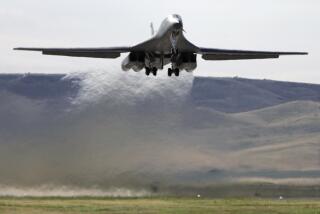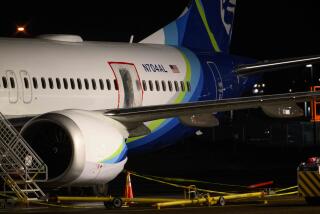FAA Urges Pilots to Improve Cockpit Discipline
KANSAS CITY — The Federal Aviation Administration called Thursday for a “hard look” at ways to improve cockpit discipline in the wake of a rash of flight crew mistakes and evidence that pilot errors may have caused a crash that killed 156 people.
FAA Administrator T. Allan McArtor told a gathering of 250 chief pilots from most of the nation’s airlines that the industry must “recapture the public’s confidence” in aviation safety with better pilot training and an insistance on cockpit professionalism.
But some pilots suggested the FAA had failed to provide adequate funds and leadership in addressing management problems faced in commercial cockpits today, citing past training programs that failed to gain adequate federal funding.
Wants Professionalism
“We’ve got to rededicate ourselves to professionalism in this industry,” McArtor said, and he suggested that if the industry does not make the improvements, “our non-aviation professionals will.”
Elaborating on the remark later, McArtor said he was concerned that Congress might seek legislative solutions to safety problems should public confidence in aviation safety continue to wane.
The FAA chief heard from more than a dozen pilots, but he acknowledged after the session that many participants probably were not as candid in their assessments during the public forum as they would have been in private meetings.
The unusual session, which was called by the FAA, came less than two weeks after the crash near Detroit of Northwest Airlines Flight 255 during takeoff, which killed 156 people.
Henry Duffy, president of the Air Line Pilots Assn., criticized the federal government for not providing money to develop better pilot training programs.
Airline pilots have been clamoring for the FAA to make mandatory a sophisticated training program used by some airlines in pilot-refresher courses.
The training program takes pilots through an ordinary flight in a simulator, but presents them with a series of distractions and tasks to perform before takeoff, during the flight and after landing. The training requires a sophisticated and expensive computer program and was pioneered by Northwest Airlines in the late 1970s. The airline is still considered to be the leader in that field.
John O’Brien, an ALPA safety specialist, said that kind of training would have been the most applicable in the Northwest crash, but the pilots involved were from old Republic Airlines, which merged with Northwest last year. They had not yet taken the Northwest training program.
Evidence from that accident is pointing increasingly toward an apparent failure by the pilots to set the wing flaps for takeoff.
More to Read
Inside the business of entertainment
The Wide Shot brings you news, analysis and insights on everything from streaming wars to production — and what it all means for the future.
You may occasionally receive promotional content from the Los Angeles Times.










